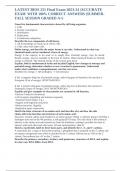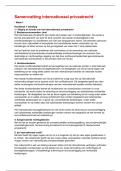LATEST BIOS 251 Final Exam 2023-24 |ACCURATE
EXAM WITH 100% CORRECT ANSWERS (SUMMER-
FALL SESSION GRADED A+)
Name five fundamental characteristics shared by all living organism.
1. Cells
2. Energy consumption
3. Information
4. Replication
5. Evolutionary adaptation
Describe the two components of cell theory.
1. All living things are made up of cell or cells.
2. Cells come from other cells.
Define energy, and describe the major forms it can take. Understand in what way
chemical bonds can be considered a form of energy.
Energy is the capacity to do work or to supply heat. Potential energy- may be stored.
Kinetic energy- may be available in the form of motion. When chemical bonds are formed,
energy is released. The internal energy of the system goes down
Explain, both in mathematical terms and in plain English, how changes in entropy and
potential energy determine whether or not a reaction is spontaneous. Understand
under what conditions a nonspontaneous reaction can occur.
ΔG(ibbs free energy) = ΔH (enthalpy) - T ΔS (entropy)
If ΔG is negative (big loss of potential energy, and/or big gain of disorder): the reaction is
Exergonic (Exit of energy). SPONTANEOUS
If ΔG is positive (big gain of potential energy, and/or big loss of disorder): the reaction is
Endergonic (Input of energy). NOT SPONTANEOUS
Explain and give examples of why proteins are essential to cell function.
-Enzyme Catalysis (chemistry)
-Cell receptors (signalling and immune response)
-Transport (food uptake, e.g.)
-Support (cell/organism structure)
-Motion (muscles, flagella)
-Regulation (gene expression)
Sketch the basic structure of an amino acid, and describe why and how the side
chains affect the function and structure of each amino acid.
Structure: Central carbon atom bonded to an amino group (-NH2), a carboxyl group (-COOH), a
hydrogen atom and in the 4th position, a side group (R-Group). The side chain is the chemical
identity to the amino acid and extends out from the backbone, making it possible for them to
interact with each other and with water. (Visual representation: slide 4)
Sketch a nucleotide, label its three basic parts, and identify the 2', 3', and 5' carbons.
A nucleotide has a sugar or deoxyribose group, a phosphate that is attached on the 5' carbon and
an organic nitrogenous base which is attached to the 3' carbon. Ribose has an -OH on the 2'
carbon, Deoxyribose has a H' on the 2' carbon.
Describe the primary, secondary, tertiary, and quaternary structures of RNA, and explain
in what ways RNA differs from DNA.
,LATEST BIOS 251 Final Exam 2023-24 |ACCURATE
EXAM WITH 100% CORRECT ANSWERS (SUMMER-
FALL SESSION GRADED A+)
RNA's primary structure consists of a sequence of nitrogen-containing bases that contain
information in the form of a molecular code. Its secondary structure includes short double
helixes and structures called hairpins that holds RNA strands together. Its tertiary and
quaternary structures that fold secondary structures into complex shapes or hold different RNA
strands together. RNA has Uracil instead of Thymine, it is single stranded, its ribose has an
extra -OH group, and it acts as a transcript of DNA expression. Also, DNA does not have a
tertiary and quaternary structure.
Explain why and how the secondary structure of DNA allows organisms to store and copy
information.
Complementary base pairing allows each strand of a DNA molecule to be copied exactly,
producing two daughter molecules. DNA's primary structure serves as a mold or template for
the synthesis of a complementary strand and DNA contains the information required for a copy
of itself to be made
Explain why RNA, and not DNA, was probably the first self-replicating molecule,
and describe at least one piece of experimental evidence that supports this hypothesis.
To make a copy of itself, the first living organism had to provide a template that could be
copied and catalyze polymerization reactions that would link monomers into a copy of that
template.
RNA is capable of both.
One experimental evidence is by Wendy Johnston and David Bartel. They found that ribozymes
isolated in each round are copied, the molecules that result are not identical in terms of their
primary sequence because mutations were introduced during the copying step. By isolating the
best enzyme and copying them in the next round, they continually selected ribozymes that were
more efficient. This was to mimic the process of natural selection
List the features shared by all carbohydrates.
A molecule made up of a bunch of carbon, hydrogen, and oxygen. These atoms are arranged in a
few specific ways: they have a carbon atom that's bonded to a carbonyl group (>C=O), several
hydroxyl functional groups (-OH), and many C-H bonds.
Sketch several representative monosaccharides, illustrating three ways in
which monosaccharides can differ from one another.
Monosaccharide have a carbonyl group at various locations , several hydroxyl functional groups
at various locations, and many carbon-hydrogen (C-H) bonds (energy). Linear form, ring form,
alpha vs beta form.
Give examples of the four major functions that carbohydrates can perform in cells (raw
materials, structure, cell identity, and chemical energy storage).
Raw materials: Sugars frequently furnish the raw "carbon skeletons" that are used as a building
blocks in the synthesis of important molecules. Amino acids use sugars as a starting point.
Structure: Cellulose and chitin, along with modified polysaccharide peptidoglycan, are key
to structural compounds. They form fibers that give cells and organisms strength and
elasticity.
Cell identity: Enormous number of structurally distinct monosaccharides make it possible for
an enormous number of unique oligosaccharides to exist. As a result, each cell type and each
,LATEST BIOS 251 Final Exam 2023-24 |ACCURATE
EXAM WITH 100% CORRECT ANSWERS (SUMMER-
FALL SESSION GRADED A+)
species can display a unique identity
Chemical energy storage: Kinetic energy in sunlight is converted to chemical energy stored
in bonds of carbohydrates by photosynthesis.
Sketch a phospholipid's molecular structure, and explain why phospholipids
spontaneously form bilayers in water.
Phospholipids have polar ends and nonpolar tails. The hydrophobic tails on the phospholipid
molecules react with one another, and are repelled by water. The polar head groups on the
phospholipids are hydrophilic and react with water. For these reasons, the phospholipids
organize themselves in such a way as to maximize the hydrophobic and hydrophilic interactions.
The form that accomplishes this the best is a bilayer.
Predict which way a certain substance will diffuse, given its concentration on either side of
a selectively permeable membrane.
If a solution is hypertonic (the solution surrounding the cell has higher concentration of solutes)
water will rush out of the cell, shrinking it. If a solution is hypotonic, (the solution surrounding
the cell has less concentration of solutes) water will rush into the cell, enlarging it. If a solution is
isotonic, (the concentration of solute is the same inside and outside the cell) the water stays as is.
Describe at least three ways in which membrane proteins can help substances cross a cell
membrane.
1. Carrier proteins are in the phospholipid bilayer (the membrane) and they transport large
molecules: glucose and amino acids via the proteins by changing the shape of them to make
them more easy to transport.
2. Channel proteins: Used for ions (as the membrane is polar and so cannot transport
charged particles), and they can be gated and so selected about what they allow through the
protein.
3. Active Transport: Using ATP (energy) to move from a low to a high concentration of
solutes (with other diffusion it is from high to low diffusion) it transports molecules using
carrier proteins, the only difference is the direction e.g. from a high or a low concentration.
4. Fluid mosaic model: Due to the phospholipids in the bilayer and the fluid like consistancy
of the membrane, small non polar (non charged particles/molecules) can move through the
membrane unaided.
Define the difference between passive transport and active transport, and give examples
of each.
-Passive transport- movement is determined by concentration, movement from high to low.
Doesn't require any energy. Oxygen and water and get into cells easily (Diffusion of oxygen into
an aerobically respiring cell).
-Active transport- Moving substances across a membrane against their concentration
gradients (high to low). Requires energy (ATP). Example: a cell uses energy to pump out a
substance already present in the extracellular fluid in concentrations higher than inside the
cell
Explain what molecular "zip codes" are and how they function.
, LATEST BIOS 251 Final Exam 2023-24 |ACCURATE
EXAM WITH 100% CORRECT ANSWERS (SUMMER-
FALL SESSION GRADED A+)
Molecular "zip codes" determines where a protein should be delivered. Inside cells, materials
are transported to their destinations with the help of molecular "zip codes."
Describe the structural and functional importance of the cytoskeleton.
This provides a structural framework within the cell, and plays a role in cell division, movement,
and transport.
Explain the dynamic nature of the cell.
-Lots of chemical reactions occur each second
-Molecules constantly enter and exit across the plasma membrane
-Products move along protein fibers
The cytoskeleton continually grows and shrinks
Understand the relationship between exergonic and endergonic reactions and ATP.
ATP catalyzes endergonic
reactions. Example: ADP + Pi -->
ATP
In exergonic reactions, ATP is released.
Example: ATP --> ADP + Pi
Describe the four components of cellular respiration. Part 1.
Glycolysis:
-starts by using ATP.
-Glucose is phosphorylated to form glucose-6-phosphate.
-An enzyme rearranges this to fructose-6-phosphate.
-A phosphate group is added, making fructose-1,6-biphosphate.
-2 ATP used before any ATP is produced
-NAD+ molecules are reduced
-2 ATP produced
-Final reaction in the sequence produces another 2 ATP
For each molecule of glucose processed, the net yield is 2 NADH, 2 ATP, 2 Pyruvate. Takes
place in the cytosol.
Describe the four components of cellular respiration. Part 2.
Pyruvate Processing:
-Pyruvate reacts with a compound called coenzyme-A (CoA).
-CoA acts as a coenzyme by transferring an acetyl group to a substrate
-Pyruvate reacts with CoA to produce acetyl CoA
NADH produced. Takes place in the cytosol.
Describe the four components of cellular respiration. Part 3.
Krebs/Citric Acid Cycle:
-Acetyl-CoA reacts with 4-carbon oxaloacetate to from 6-carbon citric acid
-Two of the 6-carbons of the citric acid leave as CO2
3 NADH, 1 FADH2, 1 ATP. Takes place in the mitochondrial matrix.





